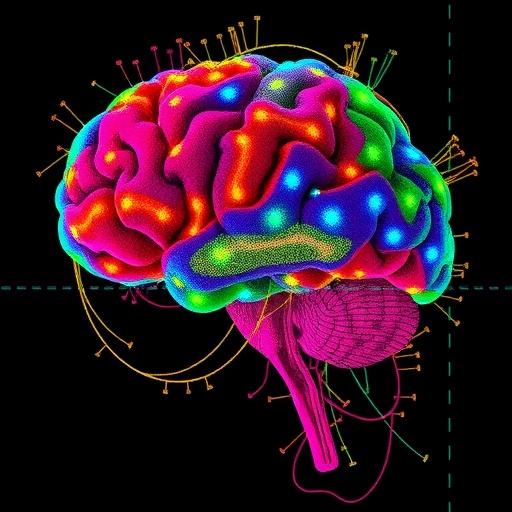
In a groundbreaking study published in Nature Communications, Ren, P., Hou, X.H., Li, Z., and their colleagues have unveiled an unprecedented atlas mapping the proteomic signatures across the intricate architecture of the human brain. This work, titled “Atlas of Proteomic Signatures of Brain Structure and Its Links to Brain Disorders,” represents a monumental stride toward decoding the molecular underpinnings of brain function and disease. By meticulously charting protein expression patterns in diverse brain regions, the research offers transformative insights into how molecular composition correlates with anatomical specialization and susceptibility to neurological disorders.
The human brain, composed of billions of neurons interwoven with glial cells, has long posed a challenge for researchers aiming to connect molecular biology to cognitive and behavioral phenotypes. Although advances in neuroimaging and genomics have brought substantial progress, the proteome—the entire set of proteins expressed in a cell or tissue—provides a more direct link to cellular function and pathology. Proteins execute almost all biological processes, so understanding their spatial distribution and concentration is crucial for grasping the brain’s complexity and resilience. The proteomic atlas generated in this study constitutes the most detailed molecular map to date, highlighting protein variance not only across major brain regions but also within finer structural domains.
Using state-of-the-art mass spectrometry techniques combined with high-resolution anatomical dissections, the authors profiled thousands of proteins from multiple brain areas harvested from healthy donors. This comprehensive sampling allowed for quantitative comparisons between regions traditionally associated with different functions—such as the hippocampus, cerebral cortex, basal ganglia, and cerebellum—and identified unique molecular fingerprints characteristic of these structures. Importantly, the study did not simply catalog proteins; it contextualized them within functional networks, shedding light on how region-specific proteomic landscapes contribute to information processing, plasticity, and energy metabolism.
.adsslot_tpVaM04boZ{width:728px !important;height:90px !important;}
@media(max-width:1199px){ .adsslot_tpVaM04boZ{width:468px !important;height:60px !important;}
}
@media(max-width:767px){ .adsslot_tpVaM04boZ{width:320px !important;height:50px !important;}
}
ADVERTISEMENT
One of the most compelling facets of this atlas is its potential to unravel the biochemical basis of brain disorders. By integrating their proteomic data with existing knowledge of disease-associated genetic variants and neuropathological findings, the researchers uncovered distinct protein signatures linked to conditions like Alzheimer’s disease, schizophrenia, and epilepsy. These correlations suggest that disruptions in certain proteomic profiles could serve as early biomarkers or therapeutic targets, moving the field closer to personalized medicine approaches. The differential protein expression observed also hints at why some disorders preferentially affect specific brain regions despite widespread genetic risk factors.
Another ambitious aspect of the study was the application of advanced bioinformatics algorithms designed to parse the vast datasets generated by mass spectrometry. Machine learning models identified clusters of co-expressed proteins forming functional modules within each brain region. These modules corresponded with known cellular pathways such as synaptic signaling, inflammation, and mitochondrial respiration. Moreover, cross-referencing these modules with transcriptomic datasets validated the proteomic findings and emphasized the importance of post-transcriptional regulation in brain function, especially since protein abundance does not always mirror mRNA levels.
The methodological rigor underpinning this atlas warrants special mention. The authors employed meticulous quality control measures to minimize technical variability inherent in proteomic workflows. Brain samples were rapidly processed postmortem to preserve protein integrity, and replicates allowed assessment of intra-regional heterogeneity. Additionally, spatial proteomics approaches enabled localization of key proteins within the cytoarchitecture of brain tissue, providing context to bulk measurements. This level of precision ensures that the atlas can serve as a reliable reference for both basic neuroscience and clinical research globally.
Historically, large-scale brain mapping projects have prioritized structural imaging and gene expression profiles, but this proteomic focus fills a critical gap. The atlas complements initiatives like the Human Connectome Project and the Allen Brain Atlas by offering molecular depth at the protein level. This holistic perspective is essential for unraveling the brain’s multifaceted biology, as proteins ultimately drive synaptic communication, metabolic cycles, and cellular maintenance. By integrating proteomic data into multilevel brain maps, this research paves the way for more nuanced hypotheses linking molecular disturbances to cognitive deficits.
The implications extend beyond neurodegenerative and psychiatric diseases, touching on developmental neuroscience as well. Protein networks identified in this atlas may help clarify how differential protein expression guides brain maturation and how deviations contribute to neurodevelopmental disorders such as autism spectrum conditions. Moreover, the dynamic nature of the proteome means that temporal studies inspired by this atlas could reveal molecular trajectories underlying critical periods of learning and plasticity, guiding interventions to enhance cognitive health across the lifespan.
From a translational perspective, the potential to harness this proteomic atlas is enormous. Pharmaceutical research can leverage the identified protein signatures to develop more selective drugs aimed at discrete molecular targets within vulnerable brain circuits. Biomarker discovery efforts will benefit by focusing on proteins with demonstrable regional specificity and disease association, enhancing the sensitivity and specificity of diagnostic tools. Furthermore, this resource establishes a framework for integrating multi-omics data, fostering future studies that combine proteomics with metabolomics, epigenetics, and electrophysiology to obtain a multidimensional understanding of brain health and disease.
The authors acknowledge certain limitations, including the challenges of extrapolating postmortem proteomic data to living brain dynamics and the current focus on adult brains without comprehensive coverage of developmental or aging stages. Nevertheless, ongoing technological refinements in single-cell proteomics and in situ labeling techniques promise to extend this atlas’s scope, offering cell-type and temporal resolution that could revolutionize neuroscience. The research community stands to gain significantly from the accessibility of this dataset, which is openly shared for collaborative exploration.
In summary, the “Atlas of Proteomic Signatures of Brain Structure and Its Links to Brain Disorders” emerges as a scientific landmark, bridging the molecular and anatomical worlds of neuroscience. By providing an exhaustive protein-level characterization of human brain architecture, Ren and colleagues have crafted a resource that will inspire hypotheses, deepen mechanistic understanding, and accelerate therapeutic innovation. The intricate portrait of brain proteomics unveiled here underscores the complexity and elegance of our most vital organ, inviting researchers globally to decode its mysteries with newfound molecular clarity.
This study exemplifies the power of interdisciplinary collaboration, merging expertise in neuroanatomy, proteomics, computational biology, and clinical neuroscience. As the brain proteome atlas becomes incorporated into the scientific mainstream, it is expected to catalyze a paradigm shift in how brain disorders are studied and managed. Ultimately, such integrative molecular maps hold promise not only for unraveling human cognition and behavior but also for ameliorating the devastating impact of neurologic and psychiatric diseases worldwide.
Subject of Research: Proteomic mapping of human brain structures and their association with neurological disorders.
Article Title: Atlas of Proteomic Signatures of Brain Structure and Its Links to Brain Disorders
Article References:
Ren, P., Hou, XH., Li, Z. et al. Atlas of Proteomic signatures of brain structure and its links to brain disorders. Nat Commun 16, 5092 (2025). https://doi.org/10.1038/s41467-025-60185-7
Image Credits: AI Generated
Tags: advances in brain research through proteomicsanatomical specialization in the brainatlas of human brain proteinsbrain architecture and cognitive functioncellular function and brain pathologylinks between proteome and brain diseasemolecular mapping of brain structureneurobiology and protein distributionprotein expression patterns in neuroscienceproteomic signatures in brain disorderstransformative insights into brain functionunderstanding neurological disorders at a molecular level



